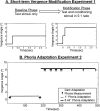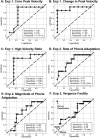Adaptation to Progressive Additive Lenses: Potential Factors to Consider
- PMID: 28566706
- PMCID: PMC5451391
- DOI: 10.1038/s41598-017-02851-5
Adaptation to Progressive Additive Lenses: Potential Factors to Consider
Abstract
People develop presbyopia as part of the normal aging process. Most presbyopes adapt to progressive additive lens (PALs), while others do not. This investigation sought to determine whether the ability to modify disparity vergence or phoria was correlated to PALs adaptation. In experiment 1, a double-step paradigm quantified the ability to modify convergence responses in sixteen presbyopes. In experiment 2, thirty-one incipient presbyopes participated in a 5-minute sustained fixation task to evoke phoria adaptation where the magnitude and rate of phoria adaptation were measured. Then, the experiment was repeated after wearing PALs for one month. Linear regression analyses were conducted between the following parameters: near point of convergence, positive fusional vergence at near, vergence facility, net change in the magnitude of phoria adaptation, and the rate of phoria adaptation. The ability to change convergence average peak velocity was significantly greater (p < 0.03) in presbyopic PALs adapters compared to presbyopic PALs non-adapters. The rate of phoria adaptation and vergence facility were significantly greater (p < 0.03) in incipient presbyopic PALs adapters compared to incipient presbyopic PALs non-adapters. Vergence facility and the rate of phoria adaptation may have potential clinical utility in differentiating which patients may adapt to PALs and which ones will have more difficulty.
Conflict of interest statement
The authors declare that they have no competing interests.
Figures








References
-
- Croft, M. A. & Kaufman, P. L. Accommodation and presbyopia: the ciliary neuromuscular view. Ophthalmol. Clin. North Am. 19, 13–24, (2006). - PubMed
Publication types
MeSH terms
Grants and funding
LinkOut - more resources
Full Text Sources
Other Literature Sources
Medical

